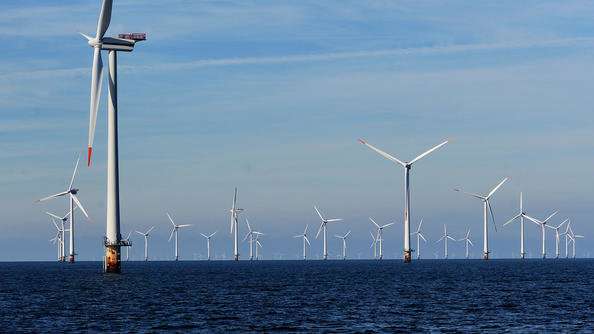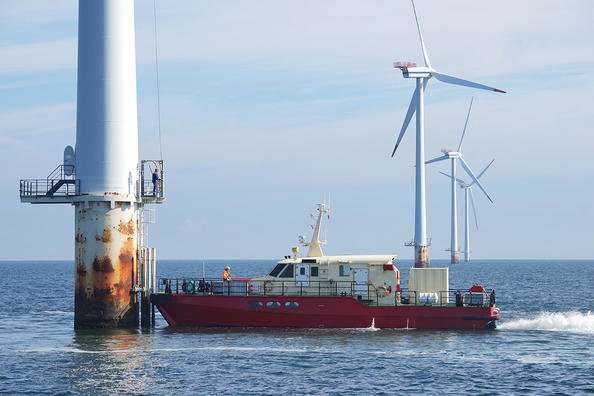Lucrative change from oil to clean energy

When Ole-Erik Vestøl Endrerud started his PhD, he didn't anticipate that his research would result in a lucrative business.
Two years after Endrerud started his PhD, he had developed simulation software which made it possible to construct, operate and maintain offshore wind turbines more effectively.
It transpired that there was a huge demand within the industry for the software he had developed, and the research fellow discovered that he needed to set up a company. Shoreline was established in 2014.
His company is now starting to take off commercially in the global offshore wind energy market. Shoreline has six employees and offices in Stavanger and Hamburg, and plans to expand to Asia and the USA. They are currently taking on more software developers.
Automisation
The company is not stopping at its offshore wind energy success. The research fellow is just beginning to realise that he and his company have created an intelligent system that could automate the work that is performed every day in any industrial plant.
"We have developed an algorithm which is unique, an algorithm which can optimise on so many parameters – which makes it useful for any type of industry", explains Endrerud.
In the beginning, they assumed that although the companies that would have a use for the software were large, there were not many of them, but it turned out that the simulation tool can be used within most big industrial facilities. The company has attracted interest from operators, turbine suppliers, vessel providers, service providers, banks and insurance institutions.
"It transpires that everyone needs a good tool to allow them to simulate construction and operation. Our market has grown from a couple of dozen customers to several hundred, if not thousands of potential customers", Endrerud points out.
From oil to renewables
Endrerud studied offshore technology at UiS. He has a Master's degree in marine and subsea technology and also in industrial technology and operations management. For a long time, his plan had been to work in a major oil company.
But first, he wanted to try out an idea he had had, and decided to go for a PhD. He wanted to solve a problem of which he had personal experience, and for which he knew that there was a need in industry: How to design the most efficient strategy possible for the operation and maintenance of an installation?
"I was not the entrepreneurial type at the time, and had no plans to develop a commercial product, but I started to become obsessed by the thought of solving this problem", said Endrerud.
At the time, the oil student had thought that the wind energy industry was just an idealistic green pipe dream. But that was before he discovered that offshore wind energy was an enormous industry abroad.
Network of experts in close contact with industry
Endrerud's research project is part of NORCOWE, a research centre for environmentally-friendly energy financed by the Research Council of Norway; his research is also affiliated with CIAM - the Cluster on Industrial Asset Management at the University of Stavanger (UiS).
It was his supervisor, Professor Jayantha P. Liyanage, who gave him the idea of simulation, or what is described as agent-based modelling. Liyanage introduced Endrerud to an international research network, which is how the research fellow established a connection with TU Delft in the Netherlands, one of the best places in the world for agent-based modelling, and a centre for intelligent maintenance systems at the University of Cincinnati in the USA.
With the support of this excellent network of experts, Endrerud developed an algorithm which later became a prototype software that could optimise the operation and maintenance of offshore wind farms – a wind farm simulator.
"The principle behind the software is that the operations engineers provide information about the wind farm, such as weather, maintenance requirements, wave height and wind strength, and we tell them what kind of production output they can expect and how high their costs will be", explains Endrerud.
This allows the operations engineers to plan and design the most efficient operational plan.
"It was incredibly important for me in the initial phase to be supported by an international network. I used the network to test out my ideas, and it gradually dawned on me that there was a huge need for a product like this. I could never have learned this without being in close contact with the people who were potential customers and experts in the field", explains the entrepreneur.
Statoil and Statkraft proved to be particularly important industrial sparring partners, and Doctor Nenad Keseric from Statoil is Endrerud's co-supervisor for his PhD.
The turning point when his life changed from being that of an ordinary research fellow whose aim was to finish his thesis, to the all-consuming life of an entrepreneur, came when Endrerud was at a seminar in Frankfurt, presenting a fully-functioning prototype of his simulation software. In the audience were several major players from the offshore energy industry. His software attracted a huge amount of interest.

Instead of licensing out the asset half way through his PhD studies, Endrerud set up the company Shoreline, assisted by the technology transfer office Validé.
Not long after this, the company landed its first contract.
Strong growth in 2016
In summer 2015, the company secured funding from Innovation Norway, after which it signed a contract with Statoil. Not long after that, the company hired its first developer.
The wind farm simulator was built and tested. The company obtained what is known as soft funding, from sources such as Innovation Norway and the Research Council of Norway's FORNY programme. Private investors were in place by the end of 2015. By then, Shoreline had a turnover of NOK 1.3 million on various consultancy projects.
At the start of 2016, they had no commercial products, but by February, the company had its first software ready for sale – an application for simulating the operation and maintenance of offshore wind farms (MAINTSYS). They sold their first subscription to Statoil in the same month. That was a huge milestone.
The commercial breakthrough came in the summer of 2016. The company then launched its second application (SIMSTALL). With this app, companies can simulate the construction of a wind farm.
This meant that over the course of the year, Shoreline had developed two software applications and ended up with subscription income of NOK 1 million. Five major customers were on the list of those who had bought subscriptions, most of them from outside Norway.
"We seem to have developed a simulation platform that can be used for a range of different products. We are now working on a third product which we hope will automate daily, short term maintenance planning in the same way as Tesla produces driverless vehicles", explains Endrerud.
The company's software developers are now using artificial intelligence to optimise how to operate and maintain large industrial facilities. This virtual planning assistant for operations and maintenance will be of interest to installations such as offshore wind farms. The system will connect to existing maintenance systems, and can automatically obtain data about weather, waves, wind, currents, logistics, personnel and work orders.
Now the company is calculating that as well as several hundred offshore wind energy customers, there are also many other industries which need the software, including the solar, hydropower, aquaculture and oil and gas industries.
"Our first marketing analysis showed us that all we have to do now is multiply the number of types of industries which are a relevant market for us, which is the coolest thing about this concept", said Endrerud.
Green entrepreneur
Shoreline has also taken part in Innovation Norway's TINC programme, which Endrerud explains is an extremely useful incubator programme in which startup companies get to fine-tune their products in the most competitive tech-hub in the world. Endrerud and his colleagues have just come back from Silicon Valley and other locations in the USA, where they had been canvassing for customers.
"Innovation Norway has an exciting facility in Silicon Valley. This has given us a foot in the door of the American market, which is one of the biggest markets in the world in onshore wind energy. There are also dozens of other industries, such as hydropower and other power producers such as solar.
As recently as June, the Rogaland branch of Innovation Norway contributed funds from its environmental technology scheme.
"Shoreline is an extremely exciting and capable company, which is growing internationally. They are helping to develop a centre of expertise in Rogaland in the fields of artificial intelligence and renewable energy. Startup companies like these are strong and important contributors to the green shift", points out Kari Holmefjord Vervik, Director of Innovation Norway Rogaland.
Although Endrerud has now realised that the simulation platform can be used in virtually any industry, he is particularly committed to the renewables industry.
"The market has proved to be many times greater than we first assumed, even if you just include offshore wind energy. We currently have 11 customers throughout the value chain in offshore wind energy, and have registered a huge demand", explains Endrerud.
The entrepreneur has great faith in the green shift, and hopes that his entrepreneurial activity will drive it forward. He is still determined that he wants his main focus to be on renewables.
"Wind is a key area for us. New wind farms are popping up every day, all over the world. It is in this area that we are devoting most of our energy. Wind and solar energy are now cheaper than coal, and global growth in these industries is in double digits. In 2017, we will have achieved the break-even figure in offshore wind energy, which means that revenues in this field will be higher than expenses", explains Endrerud.
So the entrepreneur seems to have succeeded beyond his wildest dreams, but the academic – what about him? Endrerud had already published several scientific articles, and was about to submit his thesis in December 2015. Then things took off for the company, which meant that the finishing touches to his thesis had to take a back seat.
However, he is able to assure us that 2017 will be the year that he is finally able to deliver his thesis. He wants this to include a detailed account of what has been keeping him busy over the last few years, although of course he cannot give everything away. His thesis, it seems, has become a lucrative trade secret.
Provided by University of Stavanger



















